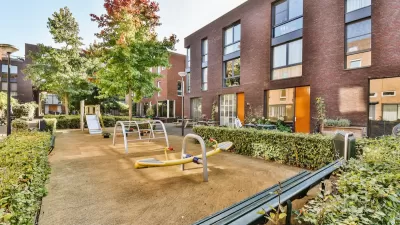For households looking for three bedrooms or more, finding rental units in walkable places is harder than ever.

“As former warehouse districts become playgrounds for college grads rather than toddlers and yesterday's streetcar suburbs become today's targets for institutional investors' portfolios, families searching for an affordable, three-bedroom apartment accessible to public transit have found them nearly impossible to find,” write Barry Greene Jr. in Streetsblog USA.
In part, this is because “Developers typically receive less money for square footage when building three-bedroom units.” But Greene also attributes this change to cultural factors. “Increasingly, we've noticed in our own area that families with young children are being erased from the marketing of new urban residential developments, which offer amenities like dog parks, pet washing stations and even ‘listening rooms’ for music lovers rather than playgrounds or kid-friendly pools.”
This doesn’t only apply to the parents of young children. “ I share this sentiment with families taking in aging parents for care, families who chose multigenerational living for their children, and families who rely on remote or hybrid work,” Greene adds.
Greene sees several policy levers that cities could use to support more family-oriented housing. “For starters, at the absolute minimum, cities should enact zoning reforms to make three-bedroom apartments legal to build in walkable, transit-oriented areas.” Greene also suggests development incentives such as tax abatements to combat what he sees as “a frightening trend” that pushes families and children away from vibrant urban neighborhoods.
FULL STORY: Where Have All the Three-Bedrooms in Walkable Neighborhoods Gone?

Maui's Vacation Rental Debate Turns Ugly
Verbal attacks, misinformation campaigns and fistfights plague a high-stakes debate to convert thousands of vacation rentals into long-term housing.

Planetizen Federal Action Tracker
A weekly monitor of how Trump’s orders and actions are impacting planners and planning in America.

San Francisco Suspends Traffic Calming Amidst Record Deaths
Citing “a challenging fiscal landscape,” the city will cease the program on the heels of 42 traffic deaths, including 24 pedestrians.

Defunct Pittsburgh Power Plant to Become Residential Tower
A decommissioned steam heat plant will be redeveloped into almost 100 affordable housing units.

Trump Prompts Restructuring of Transportation Research Board in “Unprecedented Overreach”
The TRB has eliminated more than half of its committees including those focused on climate, equity, and cities.

Amtrak Rolls Out New Orleans to Alabama “Mardi Gras” Train
The new service will operate morning and evening departures between Mobile and New Orleans.
Urban Design for Planners 1: Software Tools
This six-course series explores essential urban design concepts using open source software and equips planners with the tools they need to participate fully in the urban design process.
Planning for Universal Design
Learn the tools for implementing Universal Design in planning regulations.
Heyer Gruel & Associates PA
JM Goldson LLC
Custer County Colorado
City of Camden Redevelopment Agency
City of Astoria
Transportation Research & Education Center (TREC) at Portland State University
Jefferson Parish Government
Camden Redevelopment Agency
City of Claremont





























